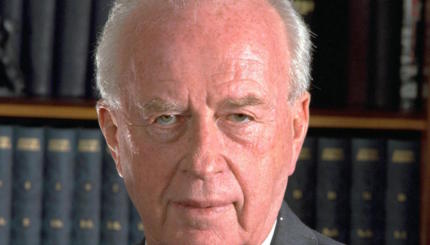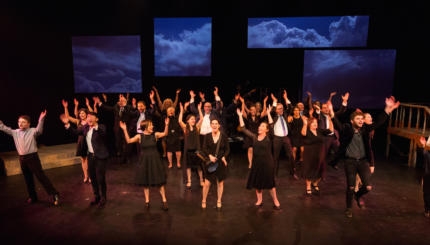In the years preceding and following the formation of the Jewish state, Israeli folk dance emerged as part of a conscious effort to increase Israel’s official folk culture. The belief at the time was that Jews living in Israel, who came from all parts of the Diaspora, needed symbols of unification to bolster their national identity. Folk dances were first created with this goal in mind.
Over the past 60 years, Israeli society has seen many changes, and today there is little agreement about what it means to be an Israeli or what constitutes “Israeli identity.” As Israel has come to accept the diversity of its Jewish population–with eclectic European, Middle Eastern, African, and now American backgrounds–the original political rationale for folk dancing has become largely out-of-date. In arts and culture in general, Israel is no longer overtly preoccupied with the formation of a unified, monolithic national identity.
Despite the changing political and social climate, in some circles in Israel, folk dance continues to blossom and enjoy popularity. Many Israeli folk dancers say they dance for the pleasure that stems from a feeling of belonging–they are not concerned with the original values the dances intended to espouse.
An Uncertain Future
And yet the future of Israeli folk dance is not certain. Some fear that folk dancing will become important only to a marginal group of people, as is the case with similar dance in many other countries. The fact that most Israeli folk dancers (professional and amateur) are older than 30 is hardly promising. Folk dancing aficionados commonly express the concern that the next generation of Israelis prefers bars and discos, with the contemporary forms of dance that come with them.

Help us keep Jewish knowledge accessible to millions of people around the world.
Your donation to My Jewish Learning fuels endless journeys of Jewish discovery. With your help, My Jewish Learning can continue to provide nonstop opportunities for learning, connection and growth.
Other supporters of Israeli folk dance worry that the social and national values symbolized in Israeli dance are quickly becoming extinct, and that this is emblematic of a larger problem: the shared values of Israeli society as a whole are in danger.
Then and Now
No doubt, Israeli folk dances were created for Zionist reasons. After 1948, as the first generation of children born in the state of Israel began to mature, the new society searched for authentic cultural material to call its own. Gurit Kadman, one of the seminal figures of the Israeli folk dance movement, maintained that “for people who fervently wished to have dances of our own in our lifetime, there was no choice” than to break with the traditional view that folk dance takes generations to create.
Israel’s first choreographers created folk dances based on no existing tradition. They worked with some basic elements — Hasidic, Balkan, Russian, Arabic, and Yemenite dance steps — but the dances they created conveyed a distinctly modern Zionist outlook. The pieces emphasized what one might call a classical Zionist ideal of returning to the land of old, of reviving the spirit of the days of the Bible, and of deepening love for the country and its landscape.
Perhaps the best-known of these early folk dances is Mayim Mayim (Water, Water), created by dancer Ilse Dubon in the late 1930s, when water was discovered at Na’an. Gurit Kadman’s folk dance creations include Yasem Midbar Le’Agam Mayim (He’ll Turn Desert Into Lake, 1944) and Etz Harimon (The Pomegranate Tree, 1948) — whose titles allude to their themes of Israeli agriculture productivity. Rivka Sturman, one of Israel’s most prolific and successful folk dance creators, produced countless other classics including Kuma Eha (Rise Up, Brother, 1945), Dodi Li (My Beloved is for Me, 1948), and Zemer Atik (Ancient Song, 1955).
What about the newer folk dances? Contemporary Israeli folk dances rely on the same basic elements as the dances composed by such choreographers as Dubon, Kadman, and Sturman. The formula that experts believe has preserved and will continue to preserve Israeli folk dances is a balancing of continuity and change; a balance necessary for the preservation of any tradition and folklore.
Musical Trends
For example, the songs used in folk dance today are very different from the songs of the past. Gone are the references to shepherds, camels and herds of old. But newer songs still continue to express love for the country and its beautiful landscape, and love for all living things.
Some of the new songs called “Mediterranean Pop” are a mixture of Greek, Turkish, and Arabic music. Despite their eclectic background, these songs are not removed from the hopes and anxieties of Israelis. And in spite of a shallowness in their language and banal themes, many of these songs express the old desire to be Israeli and experience “normality”–with a new awareness that there is no consensus about what it actually means to be Israeli or to be normal.
Old Dances, New Dances
An abundance of new dances also reflects both continuity and change. Dancers today are used to constant stimulation; they resent stagnation and they produce new dances at a frenzied rate. The fact that in recent years a not-for-profit movement, Reyim, was founded to preserve the old Israeli folkdances, combined with special evenings devoted to “old circle dances,” proves that dancers feel the need to preserve the basic roots of their art. The past evokes a variety of relevant memories that help dancers deal with their present and future.
And of course, nostalgia is not strictly an expression of old people. Some young people are also intrigued by the past. They want to know what their parents felt and believed, and they want to experience what they consider to be primary and basic feelings.
Combining Continuity and Change
Today some dance instructors manage to capitalize on both the elements of continuity and change in Israeli folk dance by teaching old folk dances in an atmosphere of liberation, ecstasy, enthusiasm, and relaxation–the same atmosphere that draws young people to dance clubs.
Continuity and change also converge at “Teimaniada” dance events. At these gatherings, hundreds of people, young and old, dance one traditional Yemenite step for hours on end. They dance to new, rhythmic beats of contemporary songs inspired by traditional Yemenite music.
Dance Festivals in Israel
When it comes to Israeli folk dance, continuity without change cannot last long. For example, the dance festival in Kibbutz Dalia, founded by Gurit Kadman, garnered great enthusiasm in the late 1940s and throughout the 1950s. But this once-vibrant institution was discontinued after 1968; the original kibbutz organizers had grown old, and the values of collectivity the dances conveyed had lost their importance for the next generation. The folk dance conventions in Tzemah, designed to replace the Dalia Festival, were discontinued after 10 years because of an overwhelming sense of stagnation.
In the wake of these failures, the Karmiel Festival emerged momentously in 1988. It was a novelty, a fruitful combination of folk and modern dance. It reflected choreographer Yonatan Karmon’s artistic search, and a general outburst of creativity and innovation. Karmon took full advantage of the beautiful Karmiel location and the participation of droves of dancers to create an aesthetic sight, in sync with the Galilee landscape around.
The festival has unique status in Israeli culture. It is a distinct expression of love of Israeli folk dance and identification with the values and symbols they have represented in the past, and still represent to some today. It seeks and showcases dance expressions of Israeli identity, in all its complexity. The festival is a multicultural event that respects the values of its roots and its multilingual community — continuity and change at their best.
Adapted and reprinted with permission from Rokdim.


